

Compact Muon Solenoid
LHC, CERN
| CMS-PAS-TOP-17-009 | ||
| Search for the standard model production of four top quarks with same-sign and multilepton final states in proton-proton collisions at $\sqrt{s}= $ 13 TeV | ||
| CMS Collaboration | ||
| September 2017 | ||
| Abstract: The standard model production of four top quarks ($\mathrm{t\overline{t}t\overline{t}}$) is studied by the CMS Collaboration using events containing at least three leptons (e, $\mu$) or a same-sign pair. The events are produced in proton-proton collisions with a center-of-mass energy of 13 TeV at the LHC, and the data sample corresponds to an integrated luminosity of 35.9 fb$^{-1}$, recorded in 2016. Jet multiplicity and flavor are used to enhance signal sensitivity, and dedicated control regions are used to constrain the dominant standard model backgrounds. The observed (expected) significance is 1.6 (1.0) standard deviations, and the $\mathrm{t\overline{t}t\overline{t}}$ cross section is measured to be 16.9$^{+13.8}_{-11.4}$ fb, in agreement with next-to-leading-order standard model predictions. These results are also used to constrain the Yukawa coupling of the top quark. | ||
|
Links:
CDS record (PDF) ;
inSPIRE record ;
CADI line (restricted) ;
These preliminary results are superseded in this paper, EPJC 78 (2018) 140. The superseded preliminary plots can be found here. |
||
| Figures | |

png pdf |
Figure 1:
Representative Feynman diagrams for ${{\mathrm{t} {}\mathrm{\bar{t}}} {\mathrm{t} {}\mathrm{\bar{t}}}}$ production at LO in the SM. |

png pdf |
Figure 1-a:
A representative Feynman diagram for ${{\mathrm{t} {}\mathrm{\bar{t}}} {\mathrm{t} {}\mathrm{\bar{t}}}}$ production at LO in the SM. |

png pdf |
Figure 1-b:
A representative Feynman diagram for ${{\mathrm{t} {}\mathrm{\bar{t}}} {\mathrm{t} {}\mathrm{\bar{t}}}}$ production at LO in the SM. |

png pdf |
Figure 1-c:
A representative Feynman diagram for ${{\mathrm{t} {}\mathrm{\bar{t}}} {\mathrm{t} {}\mathrm{\bar{t}}}}$ production at LO in the SM. |
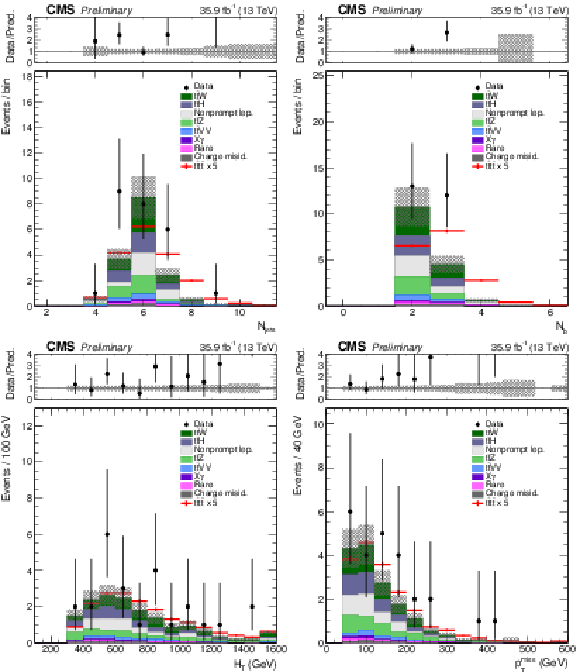
png pdf |
Figure 2:
Distributions of the main analysis variables in the signal regions (SRs 1-8), before the fit to data: $ {N_\text {jets}} $, $ {N_\text {b}} $, $ {H_{\mathrm {T}}} $, and $ {p_{\mathrm {T}}^{\text {miss}}} $, where the last bin includes the overflow. The hatched area represents the total uncertainty in the SM background prediction, while the solid line represents the $ {{\mathrm{t} {}\mathrm{\bar{t}}} {\mathrm{t} {}\mathrm{\bar{t}}}} $ signal, scaled by a factor of 5, assuming the SM cross section calculation from Ref. [17]. The upper panels show the ratio of the observed event yield and the total background prediction. |
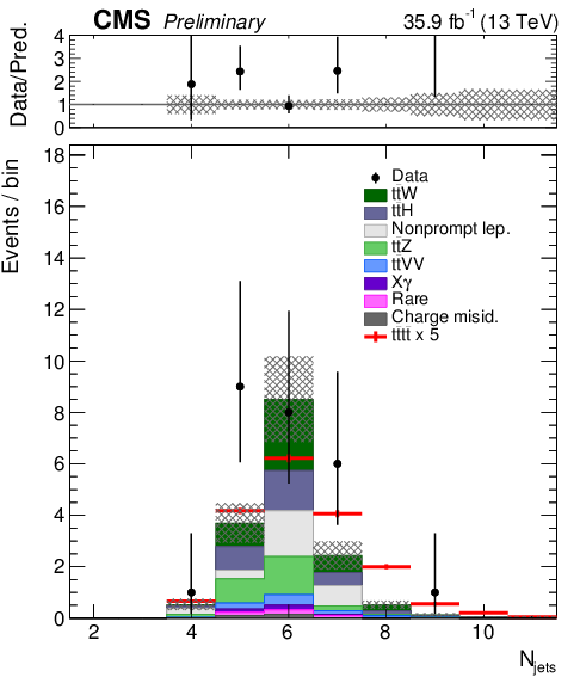
png pdf |
Figure 2-a:
Distribution of $ {N_\text {jets}} $ in the signal regions (SRs 1-8), before the fit to data, where the last bin includes the overflow. The hatched area represents the total uncertainty in the SM background prediction, while the solid line represents the $ {{\mathrm{t} {}\mathrm{\bar{t}}} {\mathrm{t} {}\mathrm{\bar{t}}}} $ signal, scaled by a factor of 5, assuming the SM cross section calculation from Ref. [17]. The upper panel shows the ratio of the observed event yield and the total background prediction. |
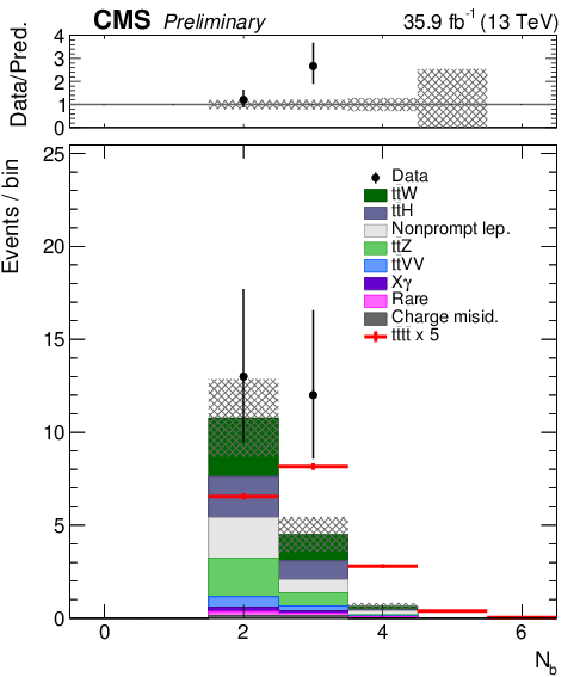
png pdf |
Figure 2-b:
Distribution of $ {N_\text {b}} $ in the signal regions (SRs 1-8), before the fit to data, where the last bin includes the overflow. The hatched area represents the total uncertainty in the SM background prediction, while the solid line represents the $ {{\mathrm{t} {}\mathrm{\bar{t}}} {\mathrm{t} {}\mathrm{\bar{t}}}} $ signal, scaled by a factor of 5, assuming the SM cross section calculation from Ref. [17]. The upper panel shows the ratio of the observed event yield and the total background prediction. |

png pdf |
Figure 2-c:
Distribution of $ {H_{\mathrm {T}}} $ in the signal regions (SRs 1-8), before the fit to data, where the last bin includes the overflow. The hatched area represents the total uncertainty in the SM background prediction, while the solid line represents the $ {{\mathrm{t} {}\mathrm{\bar{t}}} {\mathrm{t} {}\mathrm{\bar{t}}}} $ signal, scaled by a factor of 5, assuming the SM cross section calculation from Ref. [17]. The upper panel shows the ratio of the observed event yield and the total background prediction. |
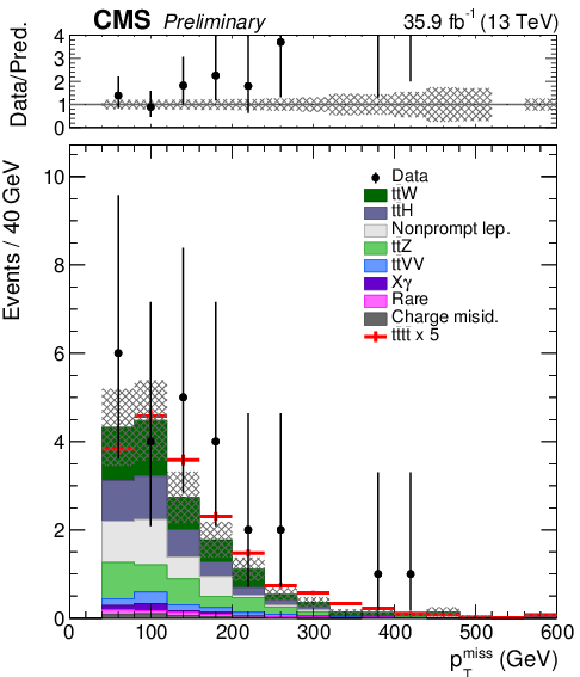
png pdf |
Figure 2-d:
Distribution of $ {p_{\mathrm {T}}^{\text {miss}}} $ in the signal regions (SRs 1-8), before the fit to data, where the last bin includes the overflow. The hatched area represents the total uncertainty in the SM background prediction, while the solid line represents the $ {{\mathrm{t} {}\mathrm{\bar{t}}} {\mathrm{t} {}\mathrm{\bar{t}}}} $ signal, scaled by a factor of 5, assuming the SM cross section calculation from Ref. [17]. The upper panel shows the ratio of the observed event yield and the total background prediction. |

png pdf |
Figure 3:
The $ {N_\text {jets}} $ (left) and $ {N_\text {b}} $ (right) distributions in the ${{\mathrm{t} {}\mathrm{\bar{t}}} \mathrm{W}}$ (top) and ${{\mathrm{t} {}\mathrm{\bar{t}}} \mathrm{Z}}$ (bottom) control regions, before the fit to data. The hatched area represents the total uncertainty in the SM background prediction, while the solid line represents the $ {{\mathrm{t} {}\mathrm{\bar{t}}} {\mathrm{t} {}\mathrm{\bar{t}}}} $ signal, scaled by a factor of 5, assuming the SM cross section calculation from Ref. [17]. The upper panels show the ratio of the observed event yield and the total background prediction. |
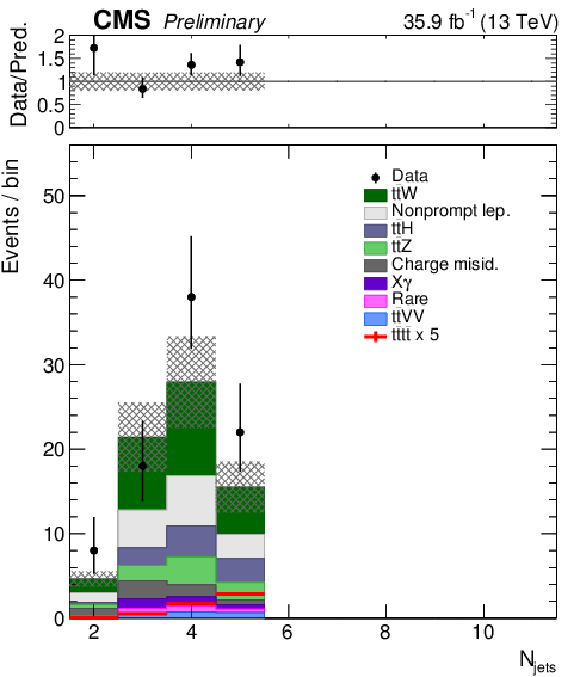
png pdf |
Figure 3-a:
The $ {N_\text {jets}} $ distribution in the ${{\mathrm{t} {}\mathrm{\bar{t}}} \mathrm{W}}$ control region, before the fit to data. The hatched area represents the total uncertainty in the SM background prediction, while the solid line represents the $ {{\mathrm{t} {}\mathrm{\bar{t}}} {\mathrm{t} {}\mathrm{\bar{t}}}} $ signal, scaled by a factor of 5, assuming the SM cross section calculation from Ref. [17]. The upper panels show the ratio of the observed event yield and the total background prediction. |
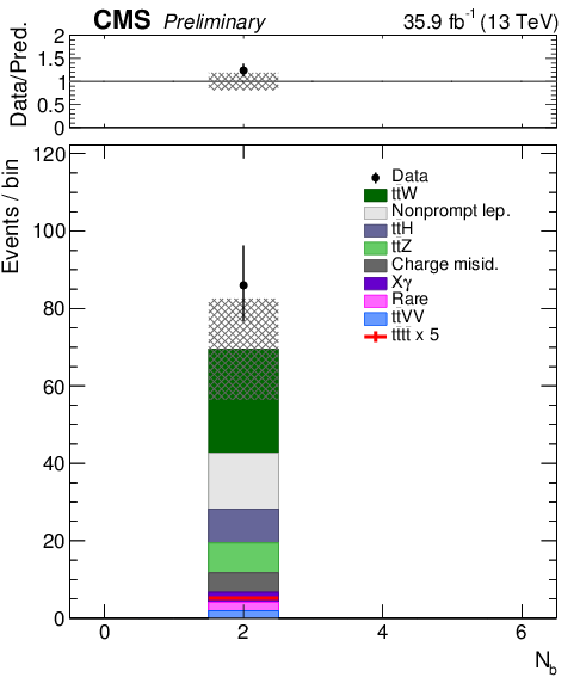
png pdf |
Figure 3-b:
The $ {N_\text {b}} $ distribution in the ${{\mathrm{t} {}\mathrm{\bar{t}}} \mathrm{W}}$ control region, before the fit to data. The hatched area represents the total uncertainty in the SM background prediction, while the solid line represents the $ {{\mathrm{t} {}\mathrm{\bar{t}}} {\mathrm{t} {}\mathrm{\bar{t}}}} $ signal, scaled by a factor of 5, assuming the SM cross section calculation from Ref. [17]. The upper panels show the ratio of the observed event yield and the total background prediction. |
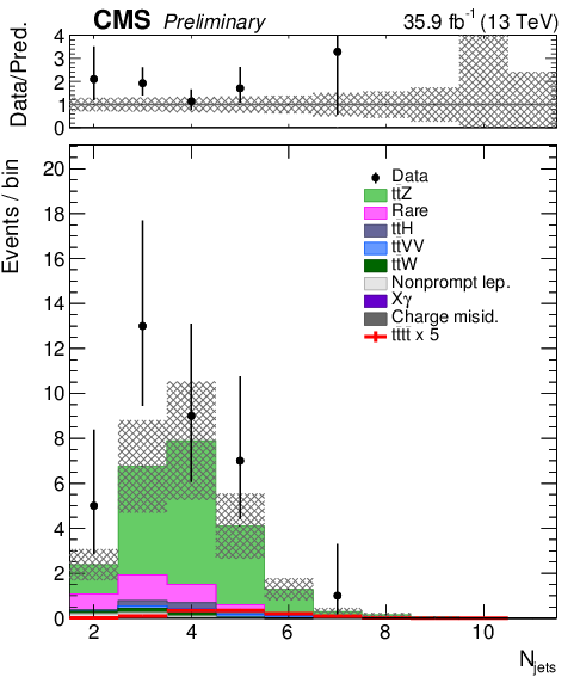
png pdf |
Figure 3-c:
The $ {N_\text {jets}} $ distribution in the ${{\mathrm{t} {}\mathrm{\bar{t}}} \mathrm{Z}}$ control region, before the fit to data. The hatched area represents the total uncertainty in the SM background prediction, while the solid line represents the $ {{\mathrm{t} {}\mathrm{\bar{t}}} {\mathrm{t} {}\mathrm{\bar{t}}}} $ signal, scaled by a factor of 5, assuming the SM cross section calculation from Ref. [17]. The upper panels show the ratio of the observed event yield and the total background prediction. |
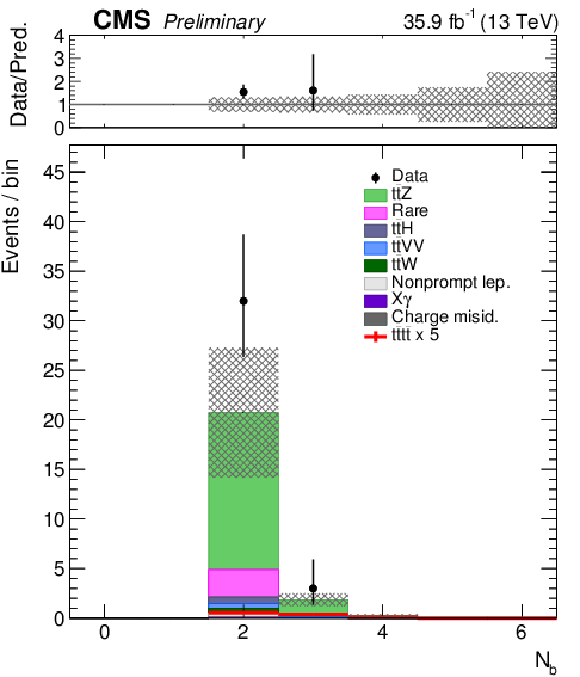
png pdf |
Figure 3-d:
The $ {N_\text {b}} $ distribution in the ${{\mathrm{t} {}\mathrm{\bar{t}}} \mathrm{Z}}$ control region, before the fit to data. The hatched area represents the total uncertainty in the SM background prediction, while the solid line represents the $ {{\mathrm{t} {}\mathrm{\bar{t}}} {\mathrm{t} {}\mathrm{\bar{t}}}} $ signal, scaled by a factor of 5, assuming the SM cross section calculation from Ref. [17]. The upper panels show the ratio of the observed event yield and the total background prediction. |
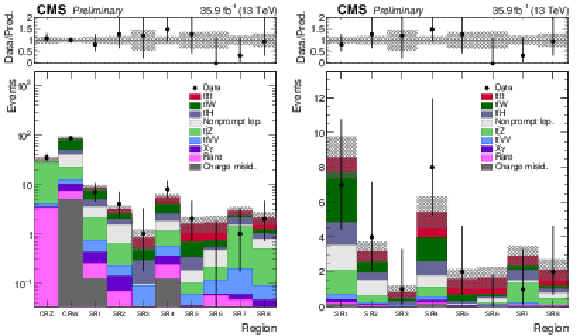
png pdf |
Figure 4:
Observed yields in the analysis control and signal regions (left, in log scale), and signal regions only (right, in linear scale), compared to the post-fit predictions for signal and background processes. The hatched area represents the total uncertainty in the signal and background predictions. The upper panels show the ratio of the observed event yield and the total prediction of signal and background. |
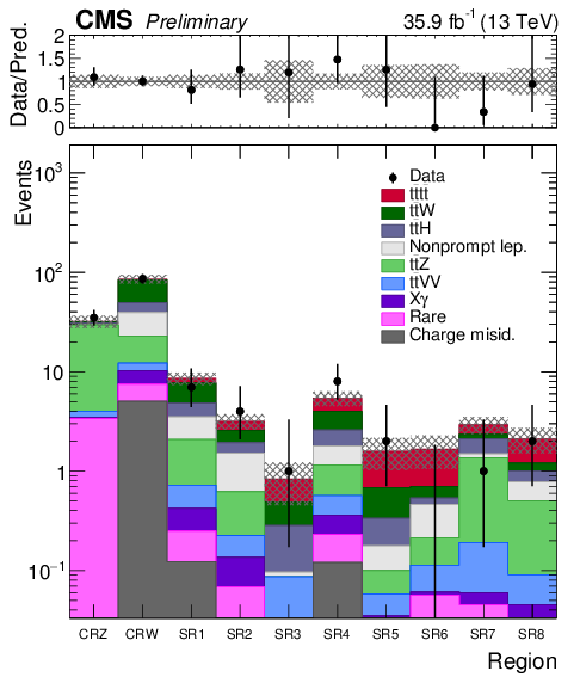
png pdf |
Figure 4-a:
Observed yields in the analysis control and signal regions (in log scale)compared to the post-fit predictions for signal and background processes. The hatched area represents the total uncertainty in the signal and background predictions. The upper panel shows the ratio of the observed event yield and the total prediction of signal and background. |
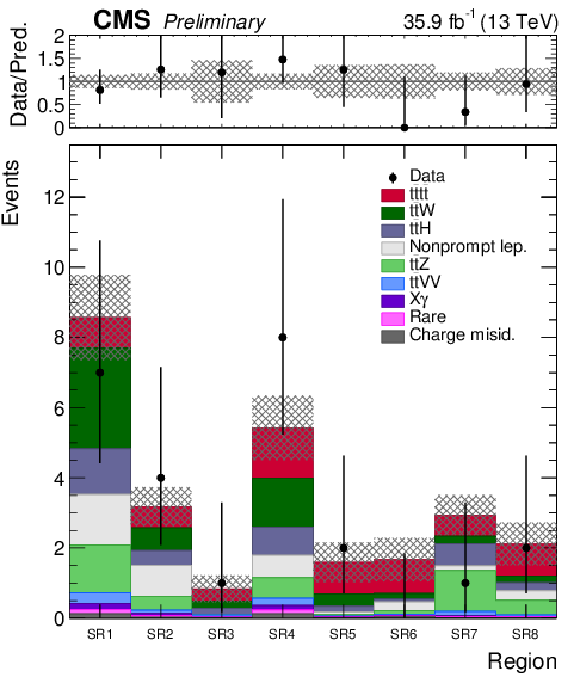
png pdf |
Figure 4-b:
Observed yields in the signal regions (in linear scale), compared to the post-fit predictions for signal and background processes. The hatched area represents the total uncertainty in the signal and background predictions. The upper panel shows the ratio of the observed event yield and the total prediction of signal and background. |
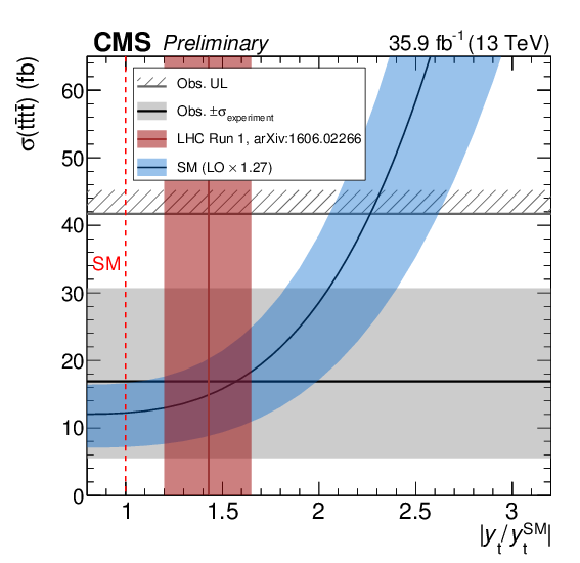
png pdf |
Figure 5:
The expected $ {{\mathrm{t} {}\mathrm{\bar{t}}} {\mathrm{t} {}\mathrm{\bar{t}}}} $ cross section, $\sigma ({{\mathrm{t} {}\mathrm{\bar{t}}} {\mathrm{t} {}\mathrm{\bar{t}}}})$, as a function of $|y_{\rm {t}}/y_{\rm {t}}^{\rm {SM}}|$, the absolute value of the ratio of the top quark Yukawa coupling and its SM value (curved band), compared with the measured $\sigma ({{\mathrm{t} {}\mathrm{\bar{t}}} {\mathrm{t} {}\mathrm{\bar{t}}}})$ (horizontal band), and its 95% CL upper limit (horizontal line). See text for details. |
| Tables | |
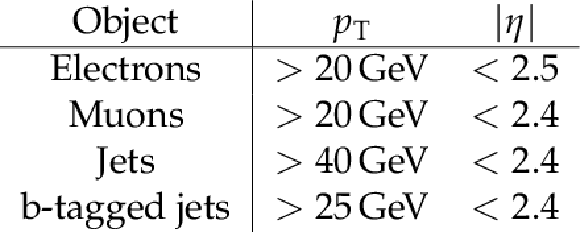
png pdf |
Table 1:
Kinematic requirements for leptons and jets. |
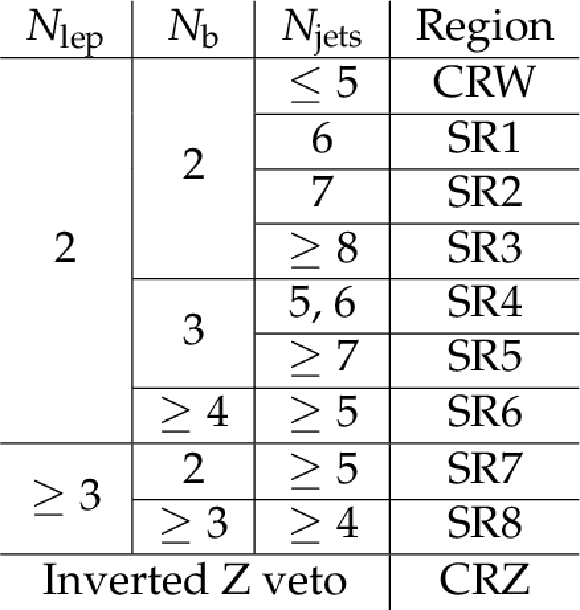
png pdf |
Table 2:
Definitions of the eight SRs and the two control regions for ${{\mathrm{t} {}\mathrm{\bar{t}}} \mathrm{W}}$ (CRW) and ${{\mathrm{t} {}\mathrm{\bar{t}}} \mathrm{Z}}$ (CRZ). |

png pdf |
Table 3:
Summary of the sources of uncertainty and their effect on the yields of different processes in the SRs. The first two groups list experimental and theoretical uncertainties, respectively, assigned to processes estimated using simulation. The third group lists uncertainties assigned to processes whose yield is estimated from data. |
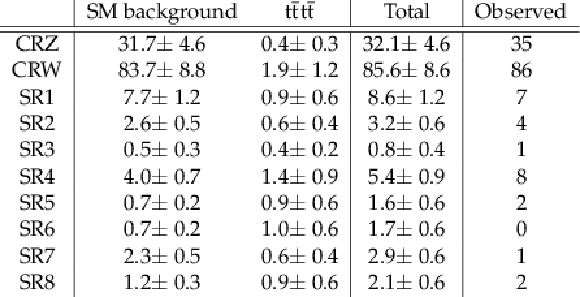
png pdf |
Table 4:
The post-fit predicted background, signal, and total yields with their uncertainties and the observed number of events in the control and signal regions. |
| Summary |
| We have presented the results of a search for the standard model ${\mathrm{t\bar{t}}\mathrm{t\bar{t}}} $ process at the LHC, using data from $\sqrt{s} = $ 13 TeV proton-proton collisions corresponding to an integrated luminosity of 35.9 fb$^{-1}$, collected with the CMS detector in 2016. The analysis strategy uses same-sign dilepton as well as three (or more) lepton events, relying on jet multiplicity and jet flavor to define search regions that are used to probe the ${\mathrm{t\bar{t}}\mathrm{t\bar{t}}} $ process. Combining these regions yields a significance of 1.6 standard deviations with respect to the background-only hypothesis, and a measured ${\mathrm{t\bar{t}}\mathrm{t\bar{t}}} $ cross section of 16.9$^{+13.8}_{-11.4} $ fb, in agreement with the standard model predictions. The results are also interpreted to constrain the ratio of the top quark Yukawa coupling to its SM value, $|y_{\rm{t}}/y_{\rm{t}}^{\rm{SM}}| < $ 2.27 at 95% confidence level. |
| References | ||||
| 1 | P. Ramond | Dual theory for free fermions | PRD 3 (1971) 2415 | |
| 2 | Y. A. Gol'fand and E. P. Likhtman | Extension of the algebra of Poincare group generators and violation of P invariance | JEPTL 13 (1971)323 | |
| 3 | A. Neveu and J. H. Schwarz | Factorizable dual model of pions | NPB 31 (1971) 86 | |
| 4 | D. V. Volkov and V. P. Akulov | Possible universal neutrino interaction | JEPTL 16 (1972)438 | |
| 5 | J. Wess and B. Zumino | A lagrangian model invariant under supergauge transformations | PLB 49 (1974) 52 | |
| 6 | J. Wess and B. Zumino | Supergauge transformations in four-dimensions | NPB 70 (1974) 39 | |
| 7 | P. Fayet | Supergauge invariant extension of the Higgs mechanism and a model for the electron and its neutrino | NPB 90 (1975) 104 | |
| 8 | H. P. Nilles | Supersymmetry, supergravity and particle physics | PR 110 (1984) 1 | |
| 9 | S. P. Martin | A supersymmetry primer | in Perspectives on Supersymmetry II, G. L. Kane, ed., World Scientific, 2010 | |
| 10 | G. R. Farrar and P. Fayet | Phenomenology of the production, decay, and detection of new hadronic states associated with supersymmetry | PLB 76 (1978) 575 | |
| 11 | T. Plehn and T. M. P. Tait | Seeking Sgluons | JPG 36 (2009) 075001 | 0810.3919 |
| 12 | S. Calvet, B. Fuks, P. Gris, and L. Valery | Searching for sgluons in multitop events at a center-of-mass energy of 8 TeV | JHEP 04 (2013) 043 | 1212.3360 |
| 13 | D. Dicus, A. Stange, and S. Willenbrock | Higgs decay to top quarks at hadron colliders | PLB 333 (1994) 126 | hep-ph/9404359 |
| 14 | N. Craig et al. | The hunt for the rest of the Higgs bosons | JHEP 06 (2015) 137 | 1504.04630 |
| 15 | N. Craig et al. | Heavy Higgs bosons at low $ \tan \beta $: from the LHC to 100 TeV | JHEP 01 (2017) 018 | 1605.08744 |
| 16 | Q.-H. Cao, S.-L. Chen, and Y. Liu | Probing Higgs width and top quark Yukawa coupling from $ {\rm t\bar{t}H} $ and $ {\rm t\bar{t}t\bar{t}} $ productions | PRD 95 (2017) 053004 | 1602.01934 |
| 17 | J. Alwall et al. | The automated computation of tree-level and next-to-leading order differential cross sections, and their matching to parton shower simulations | JHEP 07 (2014) 079 | 1405.0301 |
| 18 | G. Bevilacqua and M. Worek | Constraining BSM physics at the LHC: Four top final states with NLO accuracy in perturbative QCD | JHEP 07 (2012) 111 | 1206.3064 |
| 19 | Particle Data Group | Review of particle physics | CPC 40 (2016) 100001 | |
| 20 | CMS Collaboration | Search for standard model production of four top quarks in the lepton+jets channel in pp collisions at $ \sqrt{s} = $ 8 TeV | JHEP 11 (2014) 154 | CMS-TOP-13-012 1409.7339 |
| 21 | ATLAS Collaboration | Search for production of vector-like quark pairs and of four top quarks in the lepton-plus-jets final state in $ pp $ collisions at $ \sqrt{s}= $ 8 TeV with the ATLAS detector | JHEP 08 (2015) 105 | 1505.04306 |
| 22 | CMS Collaboration | Search for standard model production of four top quarks in proton-proton collisions at $ \sqrt{s} = $ 13 TeV | PLB 772 (2017) 336 | CMS-TOP-16-016 1702.06164 |
| 23 | CMS Collaboration | Search for physics beyond the standard model in events with two leptons of same sign, missing transverse momentum, and jets in proton-proton collisions at $ \sqrt{s}= $ 13 TeV | EPJC 77 (2017) 578 | CMS-SUS-16-035 1704.07323 |
| 24 | T. Melia, P. Nason, R. Rontsch, and G. Zanderighi | W$ ^+ $W$ ^- $, WZ and ZZ production in the POWHEG BOX | JHEP 11 (2011) 078 | 1107.5051 |
| 25 | P. Nason and G. Zanderighi | $ \mathrm{W}^+ \mathrm{W}^- $ , $ \mathrm{W} \mathrm{Z} $ and $ \mathrm{Z} \mathrm{Z} $ production in the POWHEG BOX V2 | EPJC 74 (2014) 2702 | 1311.1365 |
| 26 | LHC Higgs Cross Section Working Group Collaboration | Handbook of LHC Higgs cross sections: 4. Deciphering the nature of the Higgs sector | 1610.07922 | |
| 27 | NNPDF Collaboration | Parton distributions for the LHC Run II | JHEP 04 (2015) 040 | 1410.8849 |
| 28 | T. Sjostrand, S. Mrenna, and P. Z. Skands | A brief introduction to PYTHIA 8.1 | CPC 178 (2008) 852 | 0710.3820 |
| 29 | J. Alwall et al. | Comparative study of various algorithms for the merging of parton showers and matrix elements in hadronic collisions | EPJC 53 (2008) 473 | 0706.2569 |
| 30 | R. Frederix and S. Frixione | Merging meets matching in MC@NLO | JHEP 12 (2012) 061 | 1209.6215 |
| 31 | GEANT4 Collaboration | GEANT4 --- a simulation toolkit | NIMA 506 (2003) 250 | |
| 32 | CMS Collaboration | Measurements of $ \mathrm{t\bar{t}} $ cross sections in association with b jets and inclusive jets and their ratio using dilepton final states in pp collisions at $ \sqrt{s}= $ 13 TeV | Submitted to PLB | CMS-TOP-16-010 1705.10141 |
| 33 | CMS Collaboration | The CMS experiment at the CERN LHC | JINST 3 (2008) S08004 | CMS-00-001 |
| 34 | CMS Collaboration | The CMS trigger system | JINST 12 (2017) P01020 | CMS-TRG-12-001 1609.02366 |
| 35 | CMS Collaboration | Particle-flow reconstruction and global event description with the CMS detector | Submitted to JINST | CMS-PRF-14-001 1706.04965 |
| 36 | CMS Collaboration | Performance of electron reconstruction and selection with the CMS detector in proton-proton collisions at $ \sqrt{s} = $ 8 TeV | JINST 10 (2015) P06005 | CMS-EGM-13-001 1502.02701 |
| 37 | CMS Collaboration | Performance of CMS muon reconstruction in pp collision events at $ \sqrt{s}= $ 7 TeV | JINST 7 (2012) P10002 | CMS-MUO-10-004 1206.4071 |
| 38 | M. Cacciari, G. P. Salam, and G. Soyez | The anti-$ k_t $ jet clustering algorithm | JHEP 04 (2008) 063 | 0802.1189 |
| 39 | M. Cacciari, G. P. Salam, and G. Soyez | FastJet user manual | EPJC 72 (2012) 1896 | 1111.6097 |
| 40 | CMS Collaboration | Determination of jet energy calibration and transverse momentum resolution in CMS | JINST 6 (2011) P11002 | CMS-JME-10-011 1107.4277 |
| 41 | CMS Collaboration | Jet energy scale and resolution in the CMS experiment in pp collisions at 8 TeV | JINST 12 (2016) P02014 | CMS-JME-13-004 1607.03663 |
| 42 | CMS Collaboration | Heavy flavor identification at CMS with deep neural networks | CDS | |
| 43 | CMS Collaboration | Performance of missing energy reconstruction in 13 TeV pp collision data using the CMS detector | CMS-PAS-JME-16-004 | CMS-PAS-JME-16-004 |
| 44 | CMS Collaboration | Search for new physics in same-sign dilepton events in proton-proton collisions at $ \sqrt{s} = $ 13 TeV | EPJC 76 (2016) 439 | CMS-SUS-15-008 1605.03171 |
| 45 | CMS Collaboration | CMS luminosity measurements for the 2016 data taking period | CMS-PAS-LUM-17-001 | CMS-PAS-LUM-17-001 |
| 46 | CMS Collaboration | Identification of b quark jets at the CMS experiment in the LHC Run2 | CMS-PAS-BTV-15-001 | CMS-PAS-BTV-15-001 |
| 47 | CMS Collaboration | Search for Higgs boson production in association with top quarks in multilepton final states at $ \sqrt{s} = $ 13 TeV | CMS-PAS-HIG-17-004 | CMS-PAS-HIG-17-004 |
| 48 | ATLAS and CMS Collaborations | Procedure for the lhc higgs boson search combination in summer 2011 | ATL-PHYS-PUB-2011-011, CMS NOTE-2011/005 | |
| 49 | G. Cowan, K. Cranmer, E. Gross, and O. Vitells | Asymptotic formulae for likelihood-based tests of new physics | EPJC 71 (2011) 1554 | 1007.1727 |
| 50 | T. Junk | Confidence level computation for combining searches with small statistics | NIMA 434 (1999) 435 | hep-ex/9902006 |
| 51 | A. L. Read | Presentation of search results: the $ {\rm CL_S} $ technique | JPG 28 (2002) 2693 | |
| 52 | ATLAS and CMS Collaborations | Measurements of the Higgs boson production and decay rates and constraints on its couplings from a combined ATLAS and CMS analysis of the LHC pp collision data at $ \sqrt{s}= $ 7 and 8 TeV | JHEP 08 (2016) 045 | 1606.02266 |

|
Compact Muon Solenoid LHC, CERN |

|

|

|

|

|

|